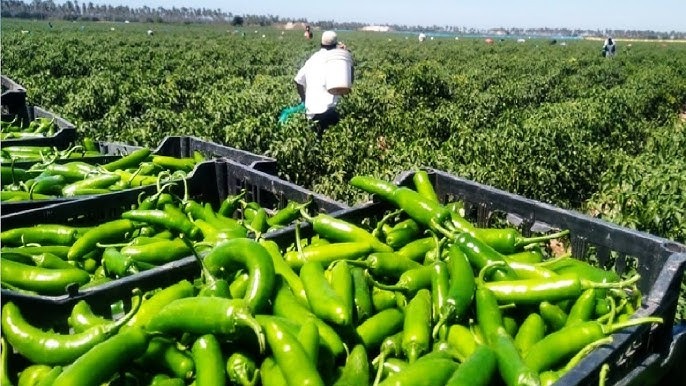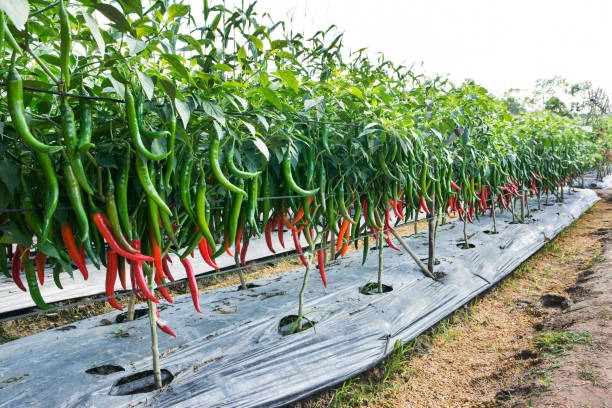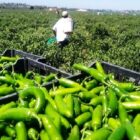
HARVEST INNOVATIONS: Green Chili Farming and Exports to the International Market
Introduction
Green chilies are an essential ingredient in global cuisine, valued for their spicy flavor, rich nutritional content, and versatility in cooking. With the increasing demand for fresh, high-quality green chilies worldwide, the export market presents lucrative opportunities for farmers and exporters. This article explores the process of green chili farming, essential quality maintenance practices, and the steps involved in exporting green chilies to international markets.
Green Chili Farming: Climate and Soil Requirements
Green chilies thrive in warm, tropical, and subtropical climates, with optimal temperatures ranging from 20°C to 30°C. Well-drained, fertile soil with a pH level between 6.0 and 7.0 is ideal for their growth. Sandy loam or clay loam soils enriched with organic matter provide essential nutrients and aeration, promoting healthy plant development.
Planting and Cultivation
The farming process begins with selecting high-quality seeds from reliable sources. Seeds are sown in nursery beds and transplanted to the main field once seedlings reach a height of 8-10 cm. Proper spacing of 45-60 cm between plants ensures adequate airflow and sunlight, reducing the risk of pests and diseases.
Regular irrigation is crucial, especially during the flowering and fruiting stages. Drip irrigation systems help maintain consistent moisture levels while conserving water. The use of organic fertilizers and compost enriches the soil, ensuring robust plant growth and higher yields.
Pest and Disease Management
Effective pest and disease management is essential for maintaining the quality of green chilies. Common pests such as aphids, whiteflies, and thrips can be controlled using eco-friendly pesticides and neem oil. Fungal diseases like powdery mildew and anthracnose can be prevented through proper field sanitation and the application of bio-fungicides.

Harvesting and Post-Harvest Handling
Green chilies are harvested when they reach full size but remain green and tender. Timely harvesting ensures optimal flavor, texture, and shelf life. Chilies are carefully handpicked to prevent bruising and damage, which could lower their market value.
After harvesting, chilies undergo cleaning, sorting, and grading based on size, color, and quality. Proper packaging in ventilated cartons or crates helps maintain freshness and prevent spoilage during transportation. Cold storage facilities further extend shelf life, ensuring that chilies remain fresh until they reach international markets.
Quality Standards for Export
To meet international market requirements, green chilies must comply with strict quality and safety standards. Exporters must adhere to regulations set by importing countries, including pesticide residue limits, hygiene protocols, and labeling requirements. Certifications from recognized authorities, such as GlobalGAP and ISO, enhance credibility and market access.
The Export Process
Market Research and Demand Analysis
Understanding the demand for green chilies in different countries is crucial for successful exports. Major markets include the Middle East, Europe, North America, and Southeast Asia, where green chilies are widely used in both traditional and modern cuisines. Conducting thorough market research helps identify potential buyers, pricing trends, and import regulations.
Documentation and Compliance
Exporting green chilies requires comprehensive documentation to ensure smooth customs clearance and compliance with international trade regulations. Key documents include:
- Phytosanitary Certificate: Confirms that the chilies are free from pests and diseases.
- Certificate of Origin: Verifies the country of production.
- Export License: Issued by the relevant government authority.
- Commercial Invoice and Packing List: Details the shipment contents and value.
- Bill of Lading or Airway Bill: Serves as proof of shipment.
Logistics and Transportation
Efficient logistics and transportation are crucial for delivering fresh green chilies to international markets. Depending on the destination, chilies are transported by air or sea to ensure timely delivery. Proper temperature control during transit prevents spoilage and maintains product quality.
Collaborating with experienced freight forwarders and customs brokers streamlines the shipping process, ensuring compliance with import regulations and minimizing delays. Ports and customs authorities provide essential support, facilitating the smooth movement of goods from farms to buyers.
Challenges and Solutions
Perishability and Shelf Life
Green chilies are highly perishable, with a limited shelf life. To address this challenge, farmers and exporters use advanced post-harvest techniques such as vacuum cooling and modified atmosphere packaging to extend freshness and reduce spoilage.
Compliance with International Standards
Meeting the diverse regulatory requirements of different countries can be complex. Exporters must stay informed about changes in import regulations and invest in quality control measures to ensure compliance. Collaborating with certification bodies and industry associations enhances credibility and market access.
Market Competition
The global green chili market is highly competitive, with major exporters including India, Mexico, Thailand, and Vietnam. To gain an edge, exporters must focus on delivering consistent quality, competitive pricing, and reliable customer service. Building strong relationships with buyers and distributors fosters long-term partnerships and repeat business.
Opportunities for Growth
Expanding Market Reach
Rising consumer demand for fresh and healthy ingredients presents significant growth opportunities for green chili exporters. By diversifying product offerings, such as organic chilies and specialty varieties, exporters can cater to niche markets and premium segments.
Value-Added Products
Processing green chilies into value-added products, such as chili powder, pickles, and sauces, extends shelf life and opens new revenue streams. These products have a longer shelf life, reducing the pressure of rapid transportation and expanding export possibilities.
Conclusion
Green chili farming and exports offer substantial economic benefits, enabling farmers and exporters to tap into the growing global demand for fresh produce. By adopting best agricultural practices, ensuring quality compliance, and leveraging efficient logistics, exporters can successfully deliver high-quality green chilies to international markets. With continuous innovation and a commitment to excellence, the future of green chili exports is set for sustainable growth and success.

